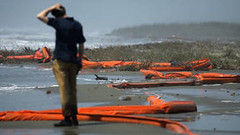
The BP oil spill in the Gulf of Mexico has created an environmental disaster endangering species as well as human ecology. The incident has also become a scandal as the debate escalates over the cause and degree of liability.
Originally uploaded by Pan-African News Wire File Photos
Wednesday, May 12, 2010; C10
Three weeks ago, an oil rig far off the coast of Louisiana was hit with a sudden, massive explosion and sank in water a mile deep. Since then, no one has been able to stop the flow of oil into the clear waters. Nearly 4 million gallons of oil have spilled into the Gulf of Mexico. If the nonstop efforts to stop it are not successful soon, it could become the nation's worst oil spill. In 1989, a leaking oil tanker spilled 11 million gallons along the coast of Alaska.
How did the oil spill happen?
After the explosion, the oil rig, called Deepwater Horizon, collapsed. The pipe that was directing oil up to the rig broke in several places, allowing the oil to rush into the open water. If you've ever seen a fire hydrant or even a kitchen sink gushing water, you have an idea of what happened.
Isn't there a way to stop the oil?
The backup system that should have stopped the flow of oil failed. Nobody knows why. Trying to fix it is hard because it's so far underwater. Think about how much pressure you feel when you dive to the bottom of a swimming pool -- then imagine being a mile underwater. Remote-controlled robots are being used to try to fix this emergency shut-off valve. They haven't been successful so far.
What else can be done?
The company that was using the rig to dig for oil, a giant British company called BP, tried to put a four-story steel and concrete box over the biggest leak and then attach a pipe to the top of the box that would bring the oil up to ships on the surface. But the box clogged up with ice formed by low temperatures and high pressure under water.
BP is also spraying chemicals on the oil to make it break up in the water, the way dish soap cuts through grease when you wash the dishes. But pouring huge amounts of chemicals into the water can also cause harm.
As a last resort, BP is digging what's called a relief well nearby that would intersect with the original well and stop the flow of oil from the original well. But digging this new well will take up to three months.
So what happens to all the oil?
The spill covers thousands of square miles and threatens the coast of Louisiana, which is home to hundreds of species of wildlife. It also threatens many jobs, such as fishing, that depend on clean water.
Ships are laying hundreds of miles of booms, which look like bright orange sausage links floating on the water, to soak up oil and keep it from reaching land. But some oil is sloshing over the booms. Sandbags also are being put down to perhaps create a wall in front of the marshlands.
A few more unusual approaches are also underway, including booms made of pantyhose packed with animal and human hair, which absorbs oil. BP is considering stuffing the well with golf balls, shredded tires and knotted rope. The idea is to try to clog the oil pipe the way a sink gets clogged.
What happens to the animals?
It's possible that many animals will die as a result of the spilled oil; they get coated in it and accidentally eat or drink it. Wildlife experts are working in the area. If the oil leak is contained soon, the damage to wildlife will be limited.
-- Margaret Webb Pressler
No comments:
Post a Comment